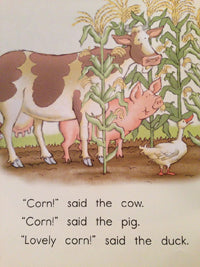 This is a guest blog post from first-grade teacher Lyssa Sahadevan that originally ran in May 2014. If you like what you read here,
you can see more of Lyssa's posts here
, or
check out her own blog here
!
This is a guest blog post from first-grade teacher Lyssa Sahadevan that originally ran in May 2014. If you like what you read here,
you can see more of Lyssa's posts here
, or
check out her own blog here
!
Characters start talking in the earliest of readers—thank goodness! Conversation is taking place, and our readers need to be ready for it! While working with a group of students on fluency, we reread one of our Joy Cowley favorites,
Wishy-Washy Tractor
. The group loves when Mrs. Wishy-Washy becomes stuck in the mud! I pointed out the first set of quotation marks to the group and asked why they were there.
“Oh, because she is talking,” they said.
I then sent them on a quotation mark hunt in their books.
They quickly noticed the words around the quotation marks, too. We created a list of words that we found. The list included said, cried, yelled, they, she, he, etc. We keep this list handy for reference and to add to later.
 We reread the book together again and stopped each time we noticed the quotation marks.
It was the perfect time to discuss who is speaking at each part of the text
(
CCSS.RL.1.6
: Identify who is telling the story at various points in a text). We changed our voices to match the characters and started brainstorming things the characters might also say. We recorded a few on dry erase boards.
We reread the book together again and stopped each time we noticed the quotation marks.
It was the perfect time to discuss who is speaking at each part of the text
(
CCSS.RL.1.6
: Identify who is telling the story at various points in a text). We changed our voices to match the characters and started brainstorming things the characters might also say. We recorded a few on dry erase boards.
This group became slightly obsessed with quotation marks.
They placed sticky notes on every page with quotation marks and started writing their own…well, trying to write their own! It is kind of like when we introduce the apostrophe-s and they add it to the end of every word!
During one of our next lessons, we found a few favorite pages and noticed where the quotation marks were and who was talking. I then wrote a sentence and had them guess who was talking. We did that several times.
Each student then said a sentence and we guessed who was talking.
The group favorite was (of course) the student mocking yours truly!
 Depending on the levels of the students, students then wrote their own quotes and drew the character who was speaking.
Some wrote one from their Mrs. Wishy-Washy book, using it as a resource. Others wrote sentences from different characters, while some wrote their own sentences and added their own quotation marks. We then shared with the group. They were a big hit and it was a perfect opportunity to review those foundational writing skills!
Depending on the levels of the students, students then wrote their own quotes and drew the character who was speaking.
Some wrote one from their Mrs. Wishy-Washy book, using it as a resource. Others wrote sentences from different characters, while some wrote their own sentences and added their own quotation marks. We then shared with the group. They were a big hit and it was a perfect opportunity to review those foundational writing skills!
I am so glad I slowed down and spent time with quotation marks
early in the year so my readers (at so many different levels) could have an understanding of just what they mean AND how they impact the story. They hold someone’s words. They help us picture the story in our head and feel how the character feels. They are meant to be read as the character would say them. They are important and my readers know that!
I’m including a copy of a few of the activity (different levels) we used to practice writing our own quotes. You can download them at the bottom of the page.
~~~
Lyssa Sahadevan is a first-grade teacher in Marietta, GA. She loves reader's and writer's workshop, is a former Teacher of the Year, and shares ideas at www.mymommyreads.com .
~~~
To download the free activity, click the image to the left below. To download an information sheet with more information about the series Joy Cowley Early Birds , which contains the books show in this post, click the image to the right.



![[Classic Post] Teaching Quotation Marks with Mrs. Wishy-Washy—with FREE download](http://www.hameraypublishing.com/cdn/shop/articles/39-JCEB_46aa6622-dab4-49c1-b57e-6785f2c371b5_1024x1024.jpg?v=1689962467)

















































